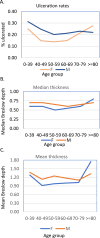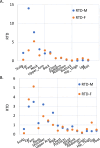A retrospective single-institute study reveals a vertical gradient of the density of cutaneous melanoma from head to toe
- PMID: 39624748
- PMCID: PMC11608879
- DOI: 10.1002/ski2.463
A retrospective single-institute study reveals a vertical gradient of the density of cutaneous melanoma from head to toe
Abstract
Background: The bodily distribution of melanoma is frequently reported without consideration of the skin surface area, which could be misleading in melanoma risk regarding anatomical sites.
Objectives: To gain insights into the melanoma distribution on the body surface when the body surface area is considered.
Methods: Cutaneous melanoma data were extracted from a single dermatopathology laboratory, and the relative density from each body site was calculated by taking into consideration the skin surface area. Data from a previous publication were analyzed as a validation. Surveillance, Epidemiology and End Results Program data were also used for comparison.
Results: Relative tumour density (RTD) of melanoma in men and women exhibits a moderate head-to-toe linear gradient, with the upper body sites showing higher density than the lower body sites in general. In particular, the ear and face show the highest RTD while the least UVR (ultraviolet radiation)-exposed buttock, abdomen and groin have the lowest, followed by the thigh and lower legs. The trend is similar in both sexes, but more obvious for men.
Conclusions: It was well documented that the trunk and lower legs are the most frequently diagnosed sites for men and women, respectively. However, when the surface area is considered, the melanoma distribution exhibits a rough head-to-toe gradient, which perhaps reflects a combined effect of solar UVR and clothing coverage. UVR protection on the face and ear should be emphasized as these are the sites with the highest RTDs.
© 2024 The Author(s). Skin Health and Disease published by John Wiley & Sons Ltd on behalf of British Association of Dermatologists.
Conflict of interest statement
The authors have declared no conflicts of interest.
Figures


Similar articles
-
Distinctive lower incidence rates of cutaneous melanoma on the hips and lower extremities of men.Clin Exp Dermatol. 2023 Nov 16;48(12):1333-1340. doi: 10.1093/ced/llad236. Clin Exp Dermatol. 2023. PMID: 37467730
-
Primary tumor sites in relation to ultraviolet radiation exposure and skin visibility correlate with survival in cutaneous melanoma.Int J Cancer. 2017 Oct 1;141(7):1345-1354. doi: 10.1002/ijc.30843. Epub 2017 Jul 12. Int J Cancer. 2017. PMID: 28635084
-
Anatomical distribution of basal cell carcinoma in Israel using relative tumor density scores.Int J Dermatol. 2021 Nov;60(11):1373-1375. doi: 10.1111/ijd.15577. Epub 2021 May 20. Int J Dermatol. 2021. PMID: 34013970
-
Spatial density of primary malignant melanoma in sun-shielded body sites: A potential guide to melanoma genesis.Acta Oncol. 2011 Apr;50(3):323-8. doi: 10.3109/0284186X.2010.535846. Epub 2011 Feb 8. Acta Oncol. 2011. PMID: 21299449 Review.
-
The Impact of Ultraviolet Radiation on the Aetiology and Development of Uveal Melanoma.Cancers (Basel). 2021 Apr 3;13(7):1700. doi: 10.3390/cancers13071700. Cancers (Basel). 2021. PMID: 33916693 Free PMC article. Review.
References
-
- Memon A, Bannister P, Rogers I, Sundin J, Al‐Ayadhy B, James PW, et al. Changing epidemiology and age‐specific incidence of cutaneous malignant melanoma in England: an analysis of the national cancer registration data by age, gender and anatomical site, 1981‐2018. Lancet Reg Health Eur. 2021;2:100024. 10.1016/j.lanepe.2021.100024 - DOI - PMC - PubMed
LinkOut - more resources
Full Text Sources
